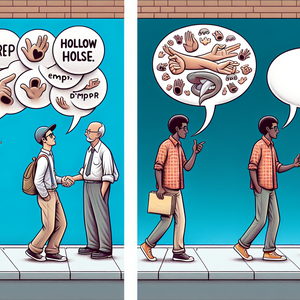The Art of the Possible: Designing Artificial Organs with Bio-Inspired Aesthetics

Nature has long been the ultimate designer, crafting organisms that are both efficient and aesthetically captivating. From the intricate patterns of a butterfly's wings to the streamlined elegance of a dolphin's body, the natural world offers a treasure trove of designs perfected over millions of years of evolution. Artificial organ designers are now tapping into this wealth of inspiration, drawing from nature's blueprints to enhance the functionality and appearance of their creations. One notable example is the development of artificial hearts. Traditionally, these devices have been bulky and mechanical, often lacking any form of aesthetic appeal. Recent advancements have seen designers adopting biomimicry principles, resulting in artificial hearts that mimic the structure and motion of a real heart. By studying the spiraled fibers in a human heart, engineers have developed artificial models that replicate the natural twisting motion, resulting in more efficient blood flow. These innovations improve the organ's performance and create a more visually harmonious device, showcasing the potential of integrating art into medical technology.
Enhancing Functionality with Bio-Inspired Designs
Adopting bio-inspired aesthetics extends beyond visual appeal; it plays a crucial role in enhancing the functionality of artificial organs. By emulating the designs found in nature, engineers can create organs that operate more seamlessly within the human body. Consider the artificial kidney. Traditional dialysis machines are cumbersome and limit patient mobility. Researchers have turned to the design of natural kidneys, which are efficient and compact, to develop wearable artificial kidneys. These devices incorporate features like the semi-permeable membrane found in natural kidneys, allowing for more effective filtration and greater patient comfort. By mirroring nature's solutions, these designs offer improved patient outcomes and quality of life.
Case Studies of Bio-Inspired Success
Several successful case studies highlight the potential of bio-inspired artificial organ design. One notable example is the development of artificial lungs that mimic the structure of fish gills. Fish gills operate with extremely high efficiency, extracting oxygen from a much denser medium than air. By adopting a similar design, artificial lungs can enhance oxygen exchange rates, benefiting patients with severe respiratory conditions. Another promising area is creating bio-inspired skin grafts. These grafts, designed with patterns similar to those found in reptile skins, allow for greater flexibility and resilience. This improves the graft's performance and offers an aesthetically pleasing result, which can be a significant factor in the psychological recovery of patients. Such innovations underscore the importance of aesthetics in medical design, proving that beauty can enhance functionality.
The pursuit of bio-inspired aesthetics in artificial organ design represents a profound shift towards integrating functionality with beauty. By taking cues from nature, designers are crafting organs that are more efficient and harmonious with the human body. This approach enhances the performance of artificial organs and redefines them as objects of art, capable of inspiring awe and appreciation. As technology and creativity continue to evolve, the future of artificial organ design promises to be as fascinating as it is life-changing, opening new possibilities at the intersection of science and aesthetics. In summary, the field of artificial organ design is evolving, influenced by nature's artistry and efficiency. As we continue to innovate, we move closer to a future where medical devices are not just functional necessities but beautiful works of art that seamlessly integrate with the human body, ultimately improving the quality of life for those who rely on them.
Biomedical Engineer - Bio-Inspired Design Specialist
Medtronic, Boston Scientific, Abbott
Job Responsibilities
Develop innovative artificial organs using principles of biomimicry, focusing on enhancing both functionality and aesthetics.
Collaborate with interdisciplinary teams, including biologists and designers, to integrate natural patterns and structures into medical devices.
Utilize advanced materials and fabrication techniques to create prototypes that mimic natural organ structures.
Unique Skill
Proficiency in bio-fabrication and a strong understanding of natural design principles.
Clinical Research Scientist - Artificial Organ Development
Johnson & Johnson, Edwards Lifesciences, Stryker
Job Responsibilities
Design and conduct experiments to test the efficacy and safety of bio-inspired artificial organs.
Analyze data to assess how design changes improve organ functionality and patient outcomes.
Work closely with regulatory bodies to ensure compliance with medical standards and guidelines.
Unique Qualification
Expertise in clinical trial design and biomimetic technologies.
Product Designer - Medical Devices with Aesthetic Focus
Philips Healthcare, GE Healthcare, Siemens Healthineers
Job Responsibilities
Create aesthetically pleasing designs for artificial organs, drawing inspiration from nature to improve user acceptance and psychological outcomes.
Develop detailed sketches and 3D models that integrate form and function seamlessly.
Collaborate with engineers and medical professionals to ensure designs meet clinical needs and technical specifications.
Unique Skill
Strong portfolio showcasing designs inspired by natural forms and a deep understanding of user-centered design principles.
Materials Scientist - Biomimetic Materials Development
DSM Biomedical, Gore Medical, DuPont
Job Responsibilities
Research and develop advanced materials that replicate the properties of natural tissues for use in artificial organs.
Focus on creating materials that are biocompatible, durable, and flexible, suitable for long-term implantation.
Collaborate with engineers and designers to integrate these materials into functional prototypes.
Unique Qualification
Experience in polymer science and nanotechnology with a focus on bio-inspired applications.
Regulatory Affairs Specialist - Medical Device Innovations
3M Health Care, Zimmer Biomet, Smith & Nephew
Job Responsibilities
Navigate the complex regulatory landscape for bio-inspired artificial organs, ensuring compliance with FDA and international standards.
Prepare and submit documentation for regulatory approval, highlighting the safety and efficacy of innovative designs.
Liaise with design and engineering teams to understand product specifications and potential regulatory challenges.
Unique Skill
In-depth knowledge of regulatory pathways for novel medical devices and experience in drafting technical files for biomimetic products.


